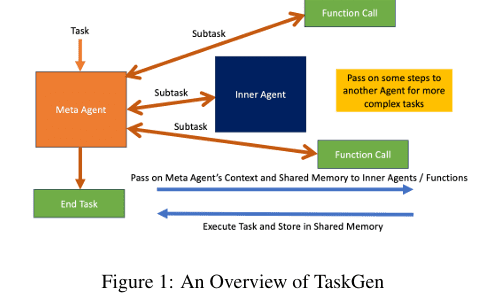- TaskGen introduces a new approach to AI task management, addressing inefficiencies in current frameworks.
- It employs a structured output format, StrictJSON, for concise and efficient data handling.
- The framework breaks down tasks into subtasks with Equipped Functions and Inner Agents for improved accuracy.
- TaskGen features an interactive retrieval method that dynamically refines context and adapts based on user interactions.
- The modular architecture includes a Memory Bank and Shared Memory system, enhancing task execution and reducing cognitive load.
- Empirical validation shows TaskGen’s high performance in tasks like maze navigation and web browsing.
- TaskGen’s design minimizes verbosity and processing latency, leading to a more streamlined system.
Main AI News:
Current AI task management frameworks, including AutoGPT, BabyAGI, and LangChain, face inefficiencies due to their reliance on free-text outputs, which often lead to context maintenance issues and suboptimal performance. Addressing these limitations, the TaskGen framework introduces a pioneering approach that enhances the capabilities of large language models (LLMs) through dynamic context refinement and interactive problem-solving.
TaskGen distinguishes itself by utilizing a structured output format known as StrictJSON, which provides concise and extractable JSON data. This structured approach significantly reduces verbosity and accelerates processing. By breaking down complex tasks into subtasks and mapping them to specific Equipped Functions or Inner Agents, TaskGen improves operational efficiency and accuracy.
A key feature of TaskGen is its interactive retrieval method, which adapts based on user query interactions to refine context dynamically. Leveraging Retrieval-Augmented Generation (RAG) systems, TaskGen incorporates additional information in iterative retrieval steps, enhancing its problem-solving capabilities without requiring conversational context. Instead, it focuses on equipping agents with specific functions and employing a modular design to optimize performance.
The framework’s modular architecture includes Equipped Functions, Inner Agents, and a Memory Bank. Equipped Functions execute defined tasks, while Inner Agents manage subtasks independently, creating a hierarchical structure that boosts processing power. The Shared Memory system ensures efficient communication among agents, sharing only pertinent information to reduce cognitive load. TaskGen’s effectiveness has been validated through various tasks, demonstrating a 100% solve rate in maze navigation and a 69% success rate in web browsing. StrictJSON’s use also contributes to decreased token consumption and processing latency.
In practical terms, TaskGen’s structured output format and modular design offer clear advantages for task execution. The reduction in free-form text verbosity leads to a more streamlined approach, while the modular components enhance performance by focusing on relevant context. The Shared Memory system supports dynamic updates and efficient management of variables, crucial for adapting to rapidly changing conditions. Additionally, the Memory Bank stores and retrieves task-related information based on semantic relevance, further augmenting the agent’s capabilities. TaskGen represents a significant advancement in AI task management, enhancing both efficiency and effectiveness.
Conclusion:
TaskGen represents a significant advancement in AI task management by addressing the limitations of existing frameworks. Its use of structured outputs and modular architecture enhances efficiency, accuracy, and adaptability in handling complex tasks. This approach not only improves task execution but also positions TaskGen as a key player in optimizing AI systems. The framework’s ability to reduce processing latency and cognitive load while improving context refinement offers substantial competitive advantages, potentially setting new standards for AI task management solutions in the market.

